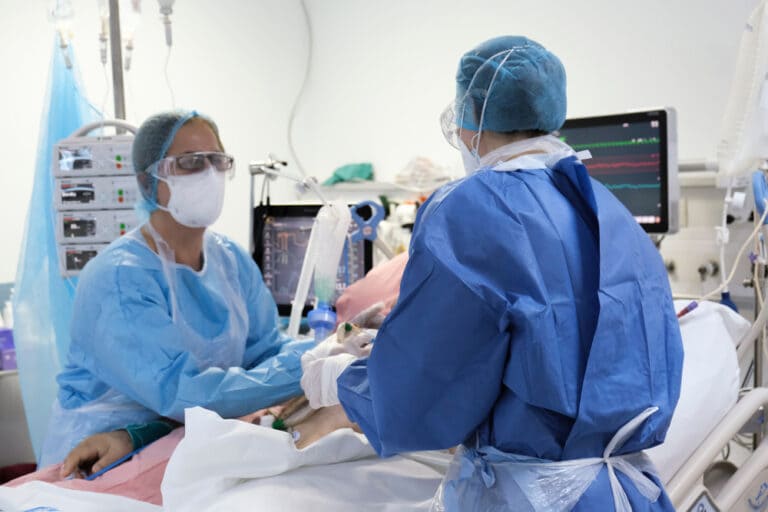


The goal of CPR (Cardiopulmonary Resuscitation) for patients who have had sudden cardiac arrests (heart attacks) or pulmonary arrests (lung failures) is to try and restore what doctors call “return of spontaneous circulation” (or ROSC).
A patient’s blood circulation will become “spontaneous” when the heart and lungs emerge from the arrested condition − thanks to CPR, such as chest compressions, rescue breathing, or both.
The heart and lungs then begin working again by themselves without the help of CPR, and the circulation of oxygenated blood to the body and brain of the patient becomes rhythmic and steady.
What happens after that, when the patient has been admitted to the hospital? Doctors need to see if the combined trauma of the heart or lung failure – plus the aggressive CPR – has caused any major impairments of various critical functions of the body. Doctors will also need to check why the heart or lungs had an arrest and try to solve the underlying health issues, so that the heart attacks or lung failure do not recur.
As with most medical practices, a Post CPR protocol helps doctors conduct all the necessary checks to address all injuries and treat underlying disease-related issues.
These 6 areas of specific monitoring and management in Post CPR care are among the most important ones:
Once ROSC has been achieved, the factors that contributed to cardiac arrest should be identified early for appropriate intervention to treat the cause. Doctors usually study the history of the events leading to the collapse, conduct careful physical examinations and investigations, and determine the cause.
Some of the commonly known causes of cardiac arrest could include:
a. Coronary artery disease: According to CDC (Centers For Disease Control and Prevention), this condition is caused by plaque buildup in the walls of the arteries that supply blood to the heart (called coronary arteries). If doctors suspect a blockage of these arteries, an emergency coronary angiogram may be needed.
b. Acute pulmonary embolism: According to UT Southwestern Medical Center, this manifests as a blockage of a pulmonary (lung) artery. The condition often results from a blood clot in the legs or another part of the body (known as deep vein thrombosis, or DVT) and travels to the lungs.
c. Cardiotoxic agents: Sometimes, drugs such as certain antidepressants, cardiac glycosides, and recreational drugs could be the main culprits that result in cardiac arrest. However, identifying the exact drug involved is usually a major challenge.
d. Metabolic disturbances: There could be several metabolic disorders, such as hyperkalemia or hypokalemia (too high or too low plasma potassium levels in the blood), or hypercalcemia (too much calcium in the blood), that can cause cardiac arrest. A Post CPR ECG may provide clues to diagnose this.
e. Sepsis: According to Mayo Clinic, sepsis is a potentially life-threatening condition where the body, in response to an infection, damages its own tissues. Sepsis is one of the common causes of cardiovascular collapse. Blood cultures are obtained, and the appropriate intravenous antibiotics are administered.
There are usually two different types of medical conditions related to airway ventilation that doctors have to contend with after ROSC.
Some patients may be awake and breathing reasonably well on their own. Some other patients, after CPR, may be comatose. These comatose patients should have a definitive airway established, and mechanical ventilation commenced.
This is usually done through “intubation,” where a tube is inserted through the patient’s mouth or nose, then down into their airway or windpipe. The tube keeps the airway open so that air can get through. The tube is connected to a machine that delivers air or oxygen.
Care must be taken to prevent hypoxia (too much oxygen in the blood) and hypocapnia (too little carbon dioxide in the blood). Either of these conditions can cause brain damage.
The medical term for blood-circulation management is “hemodynamic management.” Post-ROSC patients are often hemodynamically unstable, and their management can be challenging.
Doctors usually aim to maintain adequate blood supply to the brain and heart, and other vital organs.
One of the main goals of hemodynamic management is to avoid hypotension (low blood pressure). Post ROSC low blood pressure is believed to be one of the significant reasons for in-hospital death after CPR.
In a paper published by PubMed, titled “Significance of arterial hypotension after resuscitation from cardiac arrest” by Stephen Trzeciak et al.), they say that “Post-ROSC hypotension is common, is a predictor of in-hospital death, and is associated with diminished functional status among survivors.”
High fever levels can cause severe brain damage to patients in Post CPR and ROSC stages.
Doctors, therefore, often begin with targeted temperature cooling (also called “therapeutic hypothermia”). According to Hopkins Medicine, temperature levels should usually be reduced to 32°C–34°C for about 24 hours.
This entire process has some risks. Shivering, as a side effect of hypothermia, hurts the patient’s organs, so it has to be avoided. Also, the patient should be gradually rewarmed at approximately 0.25°C–0.33°C per hour until return to normal temperatures. Rapid rewarming can lead to cerebral damage.
In medical parlance, blood sugar management is often called “glycemic control.”
Hyperglycemia (high blood sugar levels) following ROSC has been associated with increased mortality, especially brain damage. Similarly, hypoglycemia (low blood sugar levels) is also associated with poor outcomes in critically ill patients after ROSC.
Blood sugar levels are usually monitored and then maintained by doctors using insulin therapy. Again, a delicate balance must be maintained between raising or lowering blood sugar levels, depending on each patient’s requirements and past diabetic history.
A paper titled “Post-resuscitation care” by Sohil Pothiawala, in The National Library of Medicine (Singapore Medical Journal) states, “The prevalence of seizures in post-cardiac arrest patients is about 12%–20%. Seizure is detrimental to brain function, so it should be treated promptly with anticonvulsant medication. An electroencephalogram should be performed without delay, and readings should be monitored frequently or continuously in comatose patients following ROSC.”
Besides managing seizures in Post CPR patients, doctors also go through “neuroprognostication” (i.e., trying to predict the patient’s potential for brain function recovery after the loss of consciousness during cardiac arrest and CPR).
Neuroprognostication helps doctors weigh the risks and benefits of life-sustaining treatment. Sometimes, patients may have a good chance of recovery without much brain impairment. But sometimes, doctors have to come to the sad conclusion that some patients, after recovery, would be irreparably brain damaged. In such cases, doctors may decide it’s more humane to let the patient’s life ebb naturally − than to artificially sustain the patient’s life without any hope of ever recovering from brain degradation.
Overall, the Post CPR responsibilities of doctors can be onerous and difficult. They have to do all they can to monitor, analyze, and decide what can be rectified. They also sometimes also have to face the truth that despite their best efforts to remedy some patients’ problems, it may only result in a sub-human life.
Post CPR care is no simple matter. It involves a great deal of monitoring and balanced decision-making by doctors. To a great extent, good CPR administration before patients arrive at hospitals helps doctors enormously. Here’s our clarion call you too can follow: “Be CPR-aware. Save lives. Be a Heartstrong Hero.”